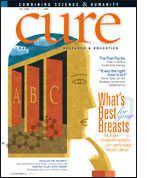Publication
Article
CURE
Pretty Is What Changes
Author(s):
A single, young, BRCA1 carrier chooses prophylactic mastectomy in Pretty Is What Changes.
Jessica Queller was a young, single television writer in 2004 when she found out she carried the BRCA1 gene, a mutation that significantly increased her risk of being diagnosed with breast or ovarian cancer. Queller decided to undergo genetic testing after her mother, who had breast cancer earlier in her life, died of ovarian cancer.
Much more than a memoir of Queller’s decision to have preventive surgery, Pretty Is What Changes takes the reader to the colorful world of television writers and the multitude of relationships, both personal and professional, that swirled around Queller while she struggled with the decision to have a prophylactic bilateral mastectomy at age 35.
Born into a family of beautiful, buxom Jewish women, Queller spends a good portion of the book on her family of origin, constructing in almost novel fashion portraits of the women whose personalities, complexities, and love created Queller’s self-image.
At the book’s beginning, Harriette, the narcissistic and larger-than-life grandmother, is dying in a New York hospital with her daughter and granddaughters at her side. Harriette, who Queller says has the mothering skills of “Medea,” was a Hollywood starlet in her youth, a part she continued to play throughout her life. Queller’s mother, Stephanie, without any mothering of her own, had difficulty relating to her own daughters until she was diagnosed with ovarian cancer soon after Harriette’s death.
Having fought two generations of women who measured perfection by appearance and possessions, Queller resisted using her body and beauty to define herself, and at the time of her mother’s death had finally found her footing as a television writer.
When Queller learns she carries the BRCA1 mutation, she adds new communities to her world—breast cancer survivors, other women with the gene mutation, and medical professionals. While sorting out what becomes terrifying new information, Queller details the complexities of dating and looking for love and family at the same time she is questioning her own mortality. Readers meet a parade of men as Queller moves toward making a decision for surgery while still hoping that before she loses her breasts she will find the man who would see beyond reconstructed breasts to the woman beneath.
There is no fairy tale ending here—just the truth of one woman’s struggle to overcome imposed beliefs about body and self to choose a better chance at life.






